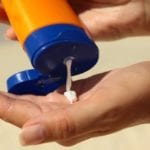 Mysteries
Mysteries  Mysteries
Mysteries  History
History 10 Surprising Stories About the Texas Rangers
 Humans
Humans 10 Philosophers Who Were Driven Mad by Their Own Theories
 Miscellaneous
Miscellaneous 10 Video-Game-Worthy Weapons and Armors from History
 Weird Stuff
Weird Stuff 10 Psychics Who Accurately Predicted Wartime Events
 The Arts
The Arts 10 Pieces of Art Inspired by a Broken Heart
 Health
Health 10 Science Fiction-Sounding New Medical Treatments
 History
History 10 Surprising Facts About the Father of Submarine Warfare
 Space
Space Ten Astonishing New Insights into Alien Worlds
 Weird Stuff
Weird Stuff 10 Bizarre Summer Solstice Rituals Still Practiced Today
 Mysteries
Mysteries Top 10 Haunting Facts About the Ghost Ship MV Alta
 History
History 10 Surprising Stories About the Texas Rangers
 Humans
Humans 10 Philosophers Who Were Driven Mad by Their Own Theories
Who's Behind Listverse?

Jamie Frater
Head Editor
Jamie founded Listverse due to an insatiable desire to share fascinating, obscure, and bizarre facts. He has been a guest speaker on numerous national radio and television stations and is a five time published author.
More About Us Miscellaneous
Miscellaneous 10 Video-Game-Worthy Weapons and Armors from History
 Weird Stuff
Weird Stuff 10 Psychics Who Accurately Predicted Wartime Events
 The Arts
The Arts 10 Pieces of Art Inspired by a Broken Heart
 Health
Health 10 Science Fiction-Sounding New Medical Treatments
 History
History 10 Surprising Facts About the Father of Submarine Warfare
 Space
Space Ten Astonishing New Insights into Alien Worlds
 Weird Stuff
Weird Stuff 10 Bizarre Summer Solstice Rituals Still Practiced Today
10 Huge Problems Animals Should Have But Don’t
Life in the wild is full of amazing adaptations and deadly dangers. While many know some of these common adaptations, from camouflage and spines to thwart predators to webbed feet and aerodynamic wings for better movement. However, some adaptations are not as common and may only be limited to a particular species.
The animals in this list have found incredible ways to survive and thrive past problems that seem impossible o solve to the unaware observer.
Related: Top 10 Amazing Prehistoric Creatures With Unexpected Adaptations
10 Woodpecker Brain Damage
The classic, bullet-like pecking of the woodpecker is perfect for punching cavities into trees to roost and nest in and to easily uncover and pluck out delicious insects and their eggs hidden beneath the bark. It’s difficult to think that blurring intense head hammering of up to 20 times a second, at up to 24kph (15 mph), wouldn’t give them horrible concussions, if not complete brain damage from all the concentrated physical stress.
Naturally though, woodpeckers are perfectly designed to take the rapid impacts, with a tiny, light brain weighing 2 grams (0.07 ounces). It’s so small that it barely absorbs any of the pecking force, which is distributed through a dense, shock-absorbing skull. They even have a special bone, the hyoid bone, which wraps around their skull like a seatbelt for their brain. The woodpecker’s protection is so impressive that athletic equipment companies have even based helmets and neck collars on its head anatomy.[1]
9 Naked Mole Rat Suffocation
Naked mole rats are known for their naked, baggy skin and digging intricate tunnel systems. Digging deep runs the risk of asphyxiation as oxygen sometimes drops drastically from an overcrowded population or lack of ventilation. But these animals can survive nearly 20 minutes without breathing, while mice die without oxygen in about 20 seconds.
Unlike all other known mammals, a naked mole rat’s brain cells don’t die or become damaged from oxygen deprivation. Its body slows to conserve energy in a vegetative state, and its metabolism becomes like a plant. Glucose burning depends on oxygen, but fructose can be turned into energy in an anaerobic pathway. Metabolizing fructose was previously thought by scientists to be only used by plants, but not anymore with this scrappy little mammal.[2]
8 Burning Echidnas
Echidnas are a spiky Australian animal that is quite slow. This means the animals can’t avoid the hot continent’s raging bushfires. But they don’t need to because they have an even better fire survival strategy than just running for dear life. Echidnas dig their small bodies down into deep, cool soil and enter a torpor state, which lowers their body temperature and metabolism.
While they nap, the bushfire above can cause the spines on their back to melt from the burning heat, turning them into blunt nubs. But though its spikes may be on scorching fire, the echidna doesn’t feel the nerveless keratin, which even regrows later on. The oblivious echidna continues happily dozing off to the inferno raging above before waking up once it’s over. They can then emerge even days later to again forage for food.[3]
7 Freezing Wood Frogs
During winter, the temperatures in Alaska and Canada can fall to -62 °C (-80 °F) at chilling, prolonged temperatures. Fortunately, most frogs survive by diving deep underwater to hibernate in coldness, where their body temperature never falls below freezing. But wood frogs have a much better strategy. They cover themselves in leaf litter on the forest floor for some insulation, but that isn’t nearly enough to protect them from the subfreezing temperatures of the north.
They actually hibernate in a frozen state, ignoring the dangers of severe body damage from freezing blood and cells, despite looking like they’ve been frozen to death. Although the wood frog allows ice to form on the outsides of its organs and cells, its liver produces a huge amount of glucose that spreads into every single body cell. This binds to water molecules and prevents lethal internal freezing. Since they’re on land already, they get a headstart on life when spring thaws them out while the underwater frogs are still waiting to heat up.[4]
6 Black Widow Sibling Cannibalism
Black widow females are known for having a bad reputation for making themselves widows, but surprisingly, their children play nice, unlike most spiderlings. Opposite most spider mothers, which lay their offspring haphazardly, letting the bigger ones born first cannibalize their younger siblings, the black widow perfectly times its eggs to all be hatched at the same size and development.
Without carefully timing the hatching of their eggs, the spiderlings would kill each other for food and competition. But at equal size and strength, none of them want to pick a fight they aren’t sure they’d win, so the black widow’s babies get along without murdering each other.[5]
5 Meerkat Sun Glare
Despite its cute doglike nose, vision is a meerkat’s best sense, so much so that meerkats are only active when the sun is out. They don’t even come out of their burrows if it’s too cloudy. As a result, meerkats need to keep a sharp eye on the sky for eagles and hawks. To do this, they have to stare straight at the sun for the sharpest lookout, which would result in painful temporary blindness for most animals.
Dark areas around their eyes, which function just like the eye black grease pro athletes wear, reduce the sun’s glare for meerkats to see far and clear with their highly developed sight. So they can spot flying predators even in bright sunlight. They have a wide field of view with their long, horizontal pupils, which lets them not waste energy turning their heads around as they watch for danger.[6]
4 Kingsnake Snake Hunting
The cottonmouth, rattlesnake, and copperhead are all fearsome names of venomous North American snakes. Their bites are fatal to humans, and you’d think any animal that hunts them must have incredible skill to avoid their fangs and kill them fast. But the kingsnake doesn’t care at all if bitten with their lethal injections.
Kingsnakes are born resistant to all their venoms, with natural enzymes that break down the toxic chemicals before they can do their work. Kingsnakes grow up to 1.8 meters (6 feet) and are nonvenomous snakes that kill with constriction, easily ruling with their special talent for killing and eating the other snakes from their region.[7]
3 Rooster Deafness
A rooster’s crow is incredibly loud, enough to rouse the whole farm with noises over 100 decibels, which is about as loud as a chainsaw. People who work with chainsaws without ear protection become deaf as their inner ear hair cells die from the loudness. However, roosters crow to their heart’s content every morning, which left scientists puzzled why the ear hairs of chickens weren’t damaged at all with hearing loss.
Analyzing the bird’s skulls, researchers found that a soft sound-absorbing tissue covered half the bird’s eardrum. Even more importantly, they discovered that a material completely covered a rooster’s ear canal whenever it tilted its head back to crow—their own natural earplugs. Also, birds regenerate cochlear hair cells, unlike mammals.[8]
2 Chopped Planarians
Being sliced and diced usually results in a brutal death, but not for the planarian. This simple aquatic flatworm can be cut into as many pieces as a scientist’s heart desires, only for all of them to regenerate into brand new worms in only a week. Their bodies are made of 20% pluripotent stem cells, which along with their simplicity, determine the rules of regeneration in the animal kingdom.
Amzingly, even 1/279th of a planarian can regrow into a full-size body, with its stem cells developing into every tissue and cell the partial planarian needs, clearly making them extremely valuable subjects of scientific research.[9]
1 Lungfish Out of Water
Most fish out of water would be as good as dead, but the lungfish is an ancient animal from 400 million years ago, with an advanced respiration system that lets it survive without any water for years. Aptly named, the lungfish has lungs in addition to gills, taking in oxygen from the air just like land animals. So during the sunny, rainless dry season, while other fish flop around in the throws of muddy death as their ponds and streams evaporate, the lungfish has an instinctive game plan.
They deeply burrow themselves headfirst by taking mud right through their mouths and squeezing it out their gills. Once they’re at a good depth, they curl their elongated bodies, so their mouth is at the top to breathe, hidden from predators and elements as they wait for the rain to return to make their watery homes. Lungfish form a protective cocoon while underground, from the hardening mucus their skin secretes, only leaving their mouths uncovered for oxygen. For up to four years, they undergo hibernation, living off the energy in their tail muscles.[10]








